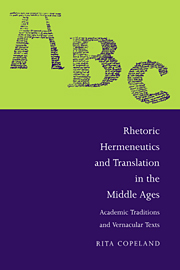Book contents
- Frontmatter
- Contents
- Acknowledgments
- List of abbreviations
- Introduction
- 1 Roman theories of translation: the fusion of grammar and rhetoric
- 2 From antiquity to the Middle Ages I: the place of translation and the value of hermeneutics
- 3 The rhetorical character of academic commentary
- 4 Translation and interlingual commentary: Notker of St. Gall and the Ovide moralisé
- 5 Translation and intralingual reception: French and English traditions of Boethius' Consolatio
- 6 From antiquity to the Middle Ages II: rhetorical invention as hermeneutical performance
- 7 Translation as rhetorical invention: Chaucer and Gower
- Afterword
- Notes
- Bibliography
- 1 Index of names and titles
- 2 General index
2 - From antiquity to the Middle Ages I: the place of translation and the value of hermeneutics
Published online by Cambridge University Press: 03 December 2009
- Frontmatter
- Contents
- Acknowledgments
- List of abbreviations
- Introduction
- 1 Roman theories of translation: the fusion of grammar and rhetoric
- 2 From antiquity to the Middle Ages I: the place of translation and the value of hermeneutics
- 3 The rhetorical character of academic commentary
- 4 Translation and interlingual commentary: Notker of St. Gall and the Ovide moralisé
- 5 Translation and intralingual reception: French and English traditions of Boethius' Consolatio
- 6 From antiquity to the Middle Ages II: rhetorical invention as hermeneutical performance
- 7 Translation as rhetorical invention: Chaucer and Gower
- Afterword
- Notes
- Bibliography
- 1 Index of names and titles
- 2 General index
Summary
In Roman contexts, as we have seen, it is rhetoric that supplies a hermeneutical model for translation. Rhetoric here is a coherent praxis in which eloquence conditions meaning and in which reason is internal to both thought and discourse. Thus translation, as a problematic of discourse, is necessarily bound up with the deepest questions of interpretation, signification, and reception. This rhetorical model of translation descended to the vernacular Middle Ages, but only by very indirect routes. The theoretical channels that mediate Roman ideas of translation to later periods so refigure or suppress the underlying rhetorical principles that the framework for translation which emerges in later medieval vernacular contexts is less a recovery of Roman ideas than a new formulation along similar lines. The forms of medieval vernacular translation that we will consider here are still grounded in models of hermeneutics and rhetoric: but the hermeneutical model re-emerges in medieval textual practices associated with grammatical studies; and the rhetorical directive is newly established through medieval redefinitions of the modus inveniendi. In this chapter and the next I will address the theoretical and practical conditions out of which new hermeneutical formulations arose in the Middle Ages. This present chapter has two purposes: to reconsider the transmission of Roman translation theory to the medieval West, and to sketch out a historical relationship between rhetoric and hermeneutics in the earlier Middle Ages. As we will see, it is through the alliance of these two academic discourses that medieval vernacular translation defines its own practice.
- Type
- Chapter
- Information
- Rhetoric, Hermeneutics, and Translation in the Middle AgesAcademic Traditions and Vernacular Texts, pp. 37 - 62Publisher: Cambridge University PressPrint publication year: 1991



